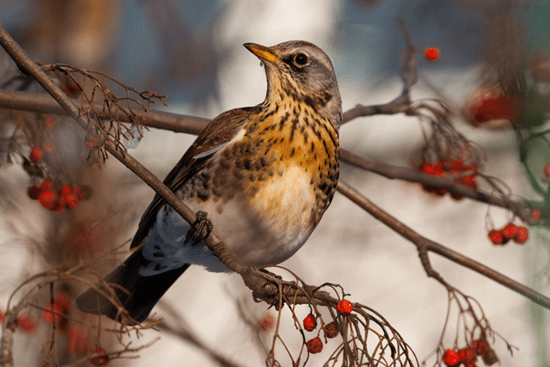Espèce dont la taille se situe entre la grive draine (5 à 10% plus petite) et la grive mauvis (25% plus grande)…………
Grive Litorne
Adulte
Grive Litorne
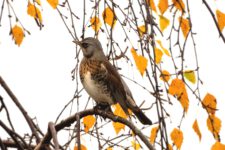
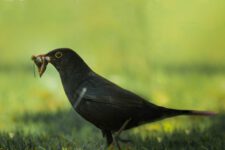
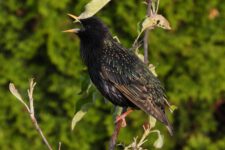
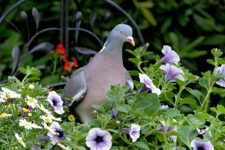
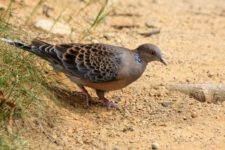
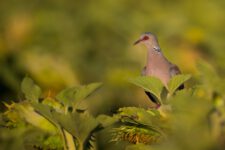
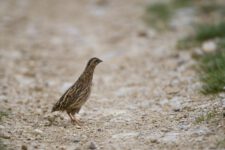
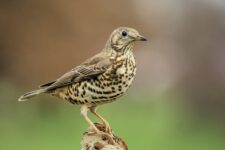
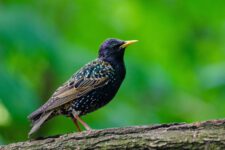
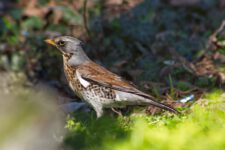
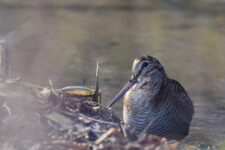
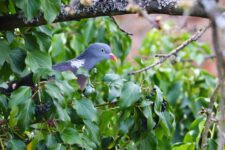
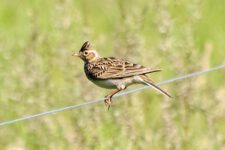
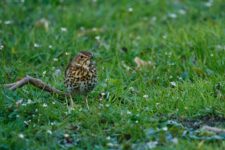
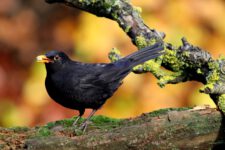
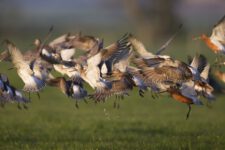
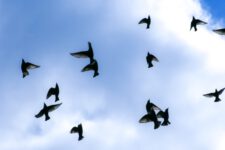
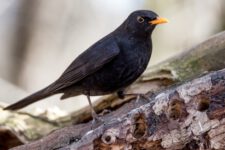
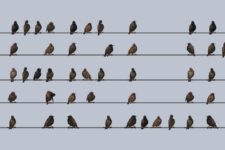
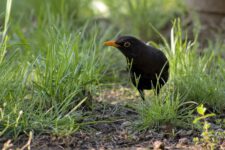
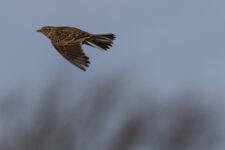
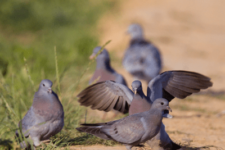
Espèce : Turdus pilaris (L1758) Grive litorne-Fieldfare-Zorzal real-Cesena
Directive 79/409 : Annexe II-2
Convention de Bern : Annexe III
Convention de Bonn : Annexe II
Etat de conservation en Europe : SPEC : catégorie 4 (favorable)(selon BLI.2004)
Statut en Europe : Sécurisé (selon BLI.2004)
Description et Identification
Espèce dont la taille se situe entre la grive draine (5 à 10% plus petite) et la grive mauvis (25% plus grande). En moyenne sa taille est de 25.5 cm et son envergure comprise entre 39 et 42 cm. Les poids moyens varient chez les mâles entre 80 et 120 g et chez les femelles entre 76 et 128 g.
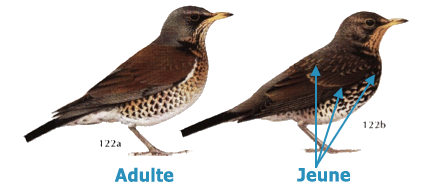
Chez les jeunes de l’année : les stries radiales sont pâles sur les parties supérieures et les taches des parties inférieures sont plus rondes que chez l’adulte. Les individus de première année peuvent parfois être distingués grâce à l’extrémité pâles des grandes couvertures (cf : supra droite).
Différences entre les sexes (adultes)
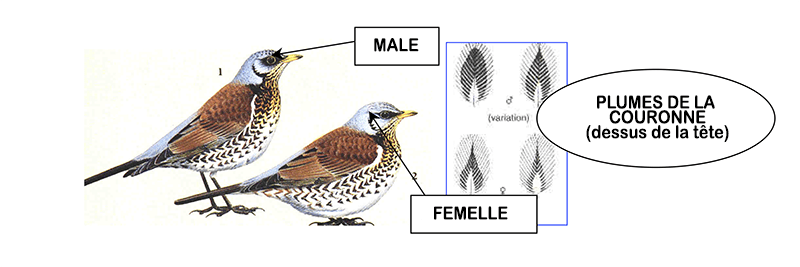
Répartition Géographique
Grive litorne : 2000-2005 (Selon 1)
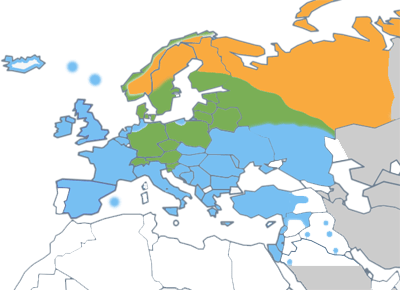
 : Espèce présente toute l’année
: Espèce présente toute l’année
 : Présente en été
: Présente en été
 : Hôte hivernal
: Hôte hivernal
Ajoutons pour la France que la présence toute l’année dans le canton de Nasbinals en Lozère a été constatée en 1995 (Ricci et Gleize.1995) témoignant de l’extension de l’aire de reproduction de l’espèce en Europe. Le département des Alpes de Haute Provence est la zone la plus méridionale de son aire de reproduction en Europe. Espèce de catégorie faunique sibérienne, oiseau de la taïga, la grive litorne a commencé son implantation comme espèce sédentaire en France en 1950 dans le massif du Jura. Depuis elle n’a cessé de coloniser les départements plus méridionaux jusque dans les Alpes du sud et en Lozère.
Répartition géographique des «sous-espèces ou races « : Pas réellement de « races » identifiées mais on note certaines variations de couleurs et de tailles selon les parties de l’aire de distribution. Les oiseaux issus des populations méridionales d’Europe centrale sont plus petits que ceux d’Europe du nord : T. p. pilaris (aile pliée des mâles 138-147 mm Vs.142- 148 mm). Brehm (1831) les considère comme T. p. subpilaris. Les populations orientales semblent plus grandes (aile pliée 146-153mm) avec le dessus de la tête d’un gris plus pâles que les autres. Certains les ont distingués en les nommant T. p. tertius.
Habitat et Alimentation
Le régime alimentaire de la Grive litorne est très varié puisqu’il concerne aussi bien des fruits sauvages ou cultivés que de nombreux invertébrés (annélides, myriapodes, gastéropodes, arachnides, insectes, etc..).
En automne et en hiver ce sont les fruits et les baies sauvages qui sont les plus consommés : pommes, raisins, baies de houx, de genièvre, de ronce mais aussi des lombrics et des gastéropodes. En plaine, les vergers de pommiers sont connus pour être très attractifs et cette culture semble bien liée à sa répartition en hiver notamment quand les zones de moyenne montagne (1000-1500 m) sont enneigées. Il en est de même des landes à genévriers (Juniperus spp ) sur les plateaux de moyenne altitude. En montagne les prairies de fauche ou pâturées constituent les habitats d’alimentation privilégiés dans lesquels elles consomment la plupart des invertébrés (lombrics, gastéropodes, larves d’insectes, …).
C’est au printemps et en été lors du nourrissage des jeunes que les invertébrés entrent pour une part majoritaire dans son régime : lombrics (5 à 15% selon les études) mais aussi les principaux ordres d’insectes : Orthoptères, Lépidoptères (larves) , Diptères (adultes et larves), Hyménoptères ( in CRAMP et SIMMONS.1988).
En Angleterre les pommiers sauvages sont régulièrement consommés en automne et en hiver mais la grive litorne semble sélectionner les fruits de l’aubépine (87%) d’où la nécessité de conserver les milieux où ces espèces se développent (friches, haies) (HARTLEY.1954).
Comme pour la plupart des autres espèces de Turdidés ayant une large niche écologique alimentaire, le régime alimentaire en un lieu et à une date donnés dépendra des disponibilités du milieu.
Reproduction
Monogame, la grive litorne s’installe fin mars début avril sur ses sites de reproduction. Le nid est placé assez haut (en moyenne 7 à 8 m).
L’espèce reste grégaire en période de reproduction et niche en petites colonies là où elle est bien implantée.
Les pontes débutent à la fin mars, comprennent 4 à 6 œufs.
L’incubation dure de 11 à 14 jours et les jeunes restent au nid 11 à 16 jours.
En moyenne 2 jeunes par nid à l’envol et 4.5 jeunes par nid réussi.
Taux de mortalité
Suisse : 60-70%, indépendant de l’âge. Finlande : taux global annuel: 61-65%. Plus vieil oiseau bagué connu : 18 ans.
Effectifs Européens
Selon le BirdLife International (2004), les effectifs de couples reproducteurs sont passés de 12 à 19 millions en moyenne entre 2000 et 2004. A partir de ces estimations de couples de 2004, L’IMPCF estime, en considérant la production moyenne de deux jeunes par couple en Europe, que les effectifs de grives litornes avant le départ en migration se situent entre 56 et 96 millions d’individus.
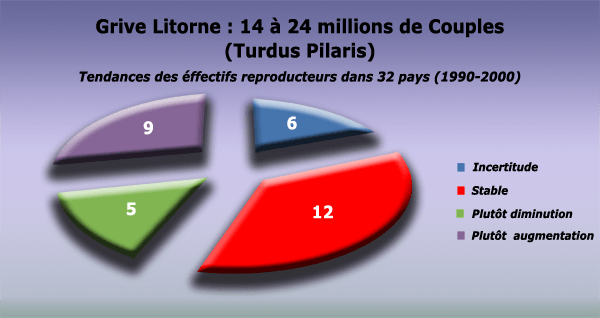
Déplacements dans le Paléarctique Occidental
Les résultats de baguage indiquent que les oiseaux scandinaves se répandent sur l’ensemble du pays, les Baltes et Russes se localisent au sud d’une ligne Ardennes-Gironde. La Région méditerranéenne est en outre visitée par des oiseaux originaires de Pologne-Tchéquie- Allemagne et Suisse. L’espèce se caractérise par des flux migratoires irréguliers d’une année sur l’autre mais souvent liés aux péjorations des conditions météorologiques au centre et au nord de l’europe. Les individus jeunes sont les plus sensibles au froid et à la neige et envahissent soudain des régions par bandes de plusieurs centaines (ou milliers d’individus).Ces bandes fréquentent notamment les prairies et les pelouses humides où elles se nourrissent de vers de terre, d’insectes et de mollusques. Les fruits entrent pour une part importante dans l’ alimentation hivernale d’où L’importance des vergers et des haies en cas de vague de froid.
Le suivi des Turdidés dont la grive litorne depuis 1990 en hivernage et en migration par L’IMPCF et les Fédérations de Chasseurs du Sud-est montre une présence de l’espèce dès la mi-novembre en migration , un hivernage très fluctuant selon les années ( variations de 0.2 à 9 oiseaux par heure de comptage selon les 14 années de suivi) et une migration de retour débutant au plus tôt au cours de la troisième décade de février avec des «pics «en première et deuxième décade de mars (cf : résultats et publications IMPCF dans les rapports scientifiques 2 et 3 de février 2004 et janvier 2005 de l’Observatoire National de la Faune Sauvage et de ses Habitats créé en 2002 par le Ministère de l’Ecologie et du Développement Durable).
Conclusion
La protection en Europe des habitats de reproduction de l’espèce (taïga, peuplements forestiers âgés comportant de grands arbres, haies, bosquets bordant des prairies ou des pelouses rases en plaine , …) doit être une priorité .La conservation et le développement des prairies de fauche et pâturées comme les pelouses de moyenne altitude s’inscrit dans les priorités de la Directive Habitats et dans les perspectives d’avenir pour le développement de cette espèce.
Plus en amont , les travaux initiés dans les pays scandinaves ( LERKELUND et al. 1993 ; HOGSTAD .1995) relatifs aux stratégies de reproduction en liaison avec la fragmentation des habitats sont à développer notamment en France où cette espèce est en phase de colonisation sur sa frange ouest et sud d’aire de répartition actuelle (RICCI et GLEIZE.1995).Dans la zone d’hivernage au sein de laquelle la France occupe une place importante notamment en cas de vague de froid , il convient de développer des mesures conservatoires de gestion cynégétique rationnelle en particulier dans les zones d’alimentation (vergers) très fréquentées en hiver. Ces mesures sont à mettre en place par concertation dans le cadre des Schémas Départementaux de Gestion Cynégétique en cours de réalisation. l’application de mesures définies dans le protocole national «vague de froid «est à encourager pour fixer les modalités de suspension momentanée de la chasse si nécessaire complétées par des résultats en cours sur l’énergétique des Turdidés tels qu’ils ont pu être obtenus chez d’autres espèces (BOOS et al.2005).
Le suivi des tendances des effectifs nicheurs , de l’évolution de l’aire de répartition en France comme de l’hivernage doit être soutenu et encouragé notamment à travers le réseau national ACT (ONCFS-FNC-FDC) et le programme STOC (MNHN). Les effets du changement global sur l’avifaune (JULIARD et al.2003) doivent être évalués en intensifiant la pression d’échantillonnage sur la base de protocoles adaptés à l’écologie et à la répartition géographique actuelle de cette espèce qui de par sa biologie peut être considérée comme une bonne espèce indicatrice. La connaissance précise des prélèvements cynégétiques par espèce constitue un des objectifs à court terme réalisé ou en cours de réalisation tant au niveau de certains départements du sud (FDC 06-11-66) qu’au niveau national par la FNC (Carnet de Prélèvement Universel) ou qu’au niveau européen dans le cadre du programme «Chasse Durable. Là comme ailleurs il conviendra de disposer d’estimateurs statistiques non biaisés (prélèvements pondérés par l’effort de chasse notamment, échantillonnage stratifié selon les espèces) afin de traduire des tendances objectives à moyen et long terme.























